Coffee Regions
Coffee beans are a particularly tricky crop to grow and harvest. Their need for such precise weather and soil conditions mean they can only grow at large scale in a few places throughout the world. Within the belt the climate and production differences from region to region can lead to a wide range of final products. This variety is what makes enjoying coffee from throughout the world a never ending adventure and one we’re glad to be a part of at Cafe Altura.
